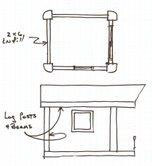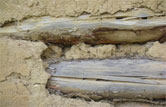Building a healthier world.
History
Log cabins are all about history, and the stories of the remarkable people who made the history. This section represents our tribute to some of the cabins of yesterday, and the people who built them and lived in them. Today, these cabins would likely fit in the category of "cottage bunkie". Few amoung us today would be comfortable living in something as snug as these cabins represent. However, for those of you looking for something small and different, or needing "just a bit more space" for "just a few more relatives", or even simply a "room of one's own", maybe such a small design would do nicely.
Catherine Parr Traill
Catherine was born in 1802 to a wealthy British merchant and warehouseman.
She and her younger sister, Susanna, married officers retired from the Napoleonic
Wars. They both chose to immigrate to Upper Canada in 1832. As both husbands
were
 also younger sons, with no possibility of inheritance, the
Colonies offered new opportunities. So it was that Catherine
Parr Traill and Susanna Moodie came to the wilderness of
Upper Canada, near what is now Peterborough, Ontario.
Both sisters wrote at length in published works (still in print)
about their experiences. Here their true natures were
revealed, as Susanna was embittered and angry, and
Catherine enthusiastic and adventuresome. Susanna and
her husband were never able to overcome their Upper Class
prejudices regarding the Lower Classes, and thus were ostracized by their
neighbours - most of whom were escaping poverty and drudgery (and
landowners like the Moodies) in their countries of origin. Catherine and her
husband Thomas embraced the land and its people alike, and were rewarded by a
tremendously more positive experience. Both families built and lived in log
cabins, made like their neighbour's homes: hewn out of the woods and built by
hand.
also younger sons, with no possibility of inheritance, the
Colonies offered new opportunities. So it was that Catherine
Parr Traill and Susanna Moodie came to the wilderness of
Upper Canada, near what is now Peterborough, Ontario.
Both sisters wrote at length in published works (still in print)
about their experiences. Here their true natures were
revealed, as Susanna was embittered and angry, and
Catherine enthusiastic and adventuresome. Susanna and
her husband were never able to overcome their Upper Class
prejudices regarding the Lower Classes, and thus were ostracized by their
neighbours - most of whom were escaping poverty and drudgery (and
landowners like the Moodies) in their countries of origin. Catherine and her
husband Thomas embraced the land and its people alike, and were rewarded by a
tremendously more positive experience. Both families built and lived in log
cabins, made like their neighbour's homes: hewn out of the woods and built by
hand.
Gentlemen Ranchers
In the 1880's, the majority of land and water rights for the lower third of Alberta were held by a handful of wealthy families in England. This was the outcome of cattle speculation, on a scale never seen previously. The opening of the land by rail made it possible to graze cattle on the Alberta frontier and then ship them back to England at a huge profit. Many of the young men who were sent to Canada to oversee their families' empires were younger sons or even what came to be known as "Remittance Men" - a derogatory term for sons being paid to stay far away from home. In addition, well-educated and well-heeled teenage boys and young men arrived in ever increasing droves, spurred on by lack of opportunities at home, grand tales of adventure and the mystique of the cowboy life. Many had never set foot out of London and had no frontier life-skills. The ones with the best chance of survival came with an endless supply of funds and/or time spent at a school back home specifically designed to prepare them for Frontier Life, such as the Public Schools' Colonial Training College at Hollesley Bay, near Woodbridge in Suffolk. Courses included such essentials as riding, shooting, surveying, geology, and veterinary science. Guest lecturers at Hollesley Bay included successful ranchers, farmers and backwoodsmen straight from Canada. Some attempts made by ranching "dudes" or "greenhorns" at cabinconstruction were better than others - one winter in Alberta would teach them faster and more thoroughly than any manual. Here's to the ones that stuck it out and came to love the mountains and rolling hills of Alberta!
Prairie Settlers: The Sodbuster
The homesteaders came hard on the heels of the cattle-ranching empire builders. A more diverse range of skills, experience and financial backing would be hard to calculate. They came by the thousands, lured by extravagantly worded posters and billboards. They came from England, Scotland, Ireland, Germany, Sweden, Denmark, Norway, Russia and the Ukraine - to name a few. They came from Ontario and Quebec. They frequently settled in small communities of established people who shared a language and culture. Some were farmers; some had never set foot on a farm before. All shared a dream of land - lots of it. Homesteaders were eligible for 160 acres - if they could prove their ability to clear it and grow crops on it. For most of the homesteaders, this was an impossible amount of land to own "back home" - if they had ever had any hope of owning any land in the first place. Obstacles included tragic battles with ranchers in the south, who viewed the homesteader's farming efforts as an affront to their previously unchallenged land and water access; as well as weather, disease, hunger, and loneliness - yet they kept coming, and they kept building. On farms all over the Western Provinces can be seen the mostly tumbled and rotting early homes of the families who first cleared the land. Enduring isolation, periodic droughts, and many other hardships with their families, they put down roots in a terribly foreign and unforgiving land - and many thrived. Let us celebrate their tenacity and courage!
Miner's Cabin
 Miners have combed the backwoods of Canada from one
coast to the other, depending on the latest find
somewhere. During the Klondike Gold Rush, 100,000
people flocked up to the Yukon. Only 30,000 made it. And
of those, a handful found enough gold to make their
sacrifices and misery worthwhile. The ones who did well,
graduated from a canvas tent or rough shack to a snug cabin as quickly as
possible. Today, the lure of the metals hidden in rock and earth still draws miners
- some in huge operations, others still slugging it out, one day at a time in a oneon-one dance with the earth.
Miners have combed the backwoods of Canada from one
coast to the other, depending on the latest find
somewhere. During the Klondike Gold Rush, 100,000
people flocked up to the Yukon. Only 30,000 made it. And
of those, a handful found enough gold to make their
sacrifices and misery worthwhile. The ones who did well,
graduated from a canvas tent or rough shack to a snug cabin as quickly as
possible. Today, the lure of the metals hidden in rock and earth still draws miners
- some in huge operations, others still slugging it out, one day at a time in a oneon-one dance with the earth.
Government Patrol Cabin
When the wilds of Alberta were patrolled by Wardens on horseback (or foot), cabins were built at strategic intervals to provide a reliable source of shelter from unpredictable and potentially deadly weather conditions. Dave's wife, Karin Dorish, had the privilege to visit such a site while working as a Junior Forest Ranger one summer several decades ago. She had volunteered, along with two other girls, to help the Fox Creek Fish and Game Warden (today they are called Conservation Officers) clean up one of the old Patrol cabins. After a two-hourlong drive over a rough grassy path in a four-wheel drive truck, they arrived at a clearing where two cabins still stood: the "old" and the "new". The old, original cabin had nearly re-joined the earth it stood on. The "new" cabin was a roomy shelter with bunk bed frames and a simple kitchen. After a long stint cleaning up inside and out, smokies were roasted on a stick and consumed with fervour. Later that day, after the long drive back to camp, Karin realized with chagrin and dismay that she had left her knife behind at the cabin. Her mom gave her the knife for her sixteenth birthday, and her name was engraved on the blade. To her astonishment, the Fish and Game Warden drove all the way back the next day to pick it up for her. To this day, Karin holds the Fish and Game Wardens (Conservation Officers) in high esteem, and remembers that special gift with gratitude.
Trappers Cabin
 Regardless of how people feel about the issues surrounding trapping; trappers represent an important part of the history of Canada. Their trap lines stretched
for miles into the wilderness, and like the Wardens, they built small cabins at
crucial intervals down their trap lines. Many people owed their lives to being able
to take shelter in one of these cabins, not only the trappers themselves, but
hunters and others lost or caught in bad storms. Let it be said that taking shelter
in a cabin does not mean an invitation to abuse that hospitality - firewood should
be replaced, and everything left intact - it is private property, after all.
Regardless of how people feel about the issues surrounding trapping; trappers represent an important part of the history of Canada. Their trap lines stretched
for miles into the wilderness, and like the Wardens, they built small cabins at
crucial intervals down their trap lines. Many people owed their lives to being able
to take shelter in one of these cabins, not only the trappers themselves, but
hunters and others lost or caught in bad storms. Let it be said that taking shelter
in a cabin does not mean an invitation to abuse that hospitality - firewood should
be replaced, and everything left intact - it is private property, after all.